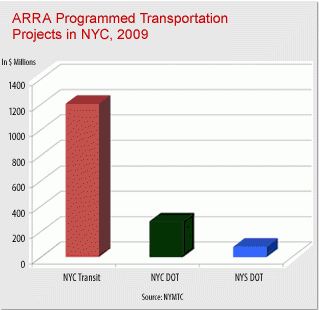
$1.5 billion in stimulus money currently approved for nyc transportation projects, but little actually spent to date
FULTON STREET TRANSIT CENTER AND SECOND AVENUE SUBWAY TO RECEIVE LION'S SHARE OF FEDERAL STIMULUS DOLLARS
A total of $1.57 billion in federal stimulus dollars has been approved to date for transportation capital projects in the five boroughs of New York City. Another $1 billion in transportation projects are likely to be approved for stimulus funding, according to a New York Building Congress analysis. However, an analysis of project data also found that virtually all of the approved capital funding has yet to be spent.
A
little less than
half of the stimulus
dollars approved
thus far will go
to support New York
City Transit’s
work on the Fulton
Street Transit Center
and the Second Avenue
Subway. A total of
$423.4 million will
flow toward Fulton
Street via the rehabilitation
of the 4/5 and A/C
subway mezzanines
and construction
on Dey Street and
the Corbin Building.
A total of $276 million
has been approved
for ongoing construction
of the Second Avenue
Subway. Of that,
$197 million is devoted
to construction of
the 96th Street subway
station.
Overall, New York
City Transit, which
is operated by the
Metropolitan Transportation
Authority, has been
approved for $1.2
billion in stimulus
funds. In addition
to the Fulton Street
and Second Avenue
projects, most of
the remaining funds
are dedicated to
the rehabilitation
of existing stations
throughout the system.
The New York City Department of Transportation (NYCDOT) has been approved for $282 million in stimulus funds. Of that total, $175 million will be used to replace the 60-year-old bus ramps at the St. George Ferry terminal on Staten Island. Other NYCDOT projects to receive stimulus funding include work on or around the Brooklyn Bridge and the Bruckner Expressway. New York State Department of Transportation (NYSDOT) projects approved for New York City total $81.1 million.
While considerable funding has been made available to New York City, and 44 projects already have been approved, very little stimulus money has actually been spent to date, according to the Office of State Comptroller Thomas P. DiNapoli. In fact, no federal dollars have yet been expended by either New York City Transit or the NYCDOT.
While there is no breakdown to date on NYSDOT expenditures, statewide, the agency has spent $278 million, which represents just six percent of the total federal stimulus dollars spent statewide in the current fiscal year.
“The transportation projects slated for stimulus funding present a positive blend of mass transit and surface transportation projects intended to maintain and expand the system,” noted Building Congress President Richard T. Anderson. “What is of great concern, however, is the slow pace of these projects. It has been almost six months since Congress and the Obama administration approved the stimulus package, yet close to nothing has been expended on the capital side.”
Mr. Anderson continued, “We have seen a good deal of spending on workforce programs and health and social services, all of which are important. Unfortunately, those expenditures do not provide the same bang for the stimulus buck as direct construction spending, which creates jobs and revenues while pumping money into the broader economy. It is incumbent upon our elected leaders and agency heads to get these dollars flowing directly into the projects already approved and likely to be approved in the coming months.”
According to State officials, of the $314M in ARRA highway and bridge funding committed to the New York City area, $215 million has been allocated to projects under the jurisdiction of New York City DOT, while $99 million is allocated to State DOT projects in the City. To spend these funds, projects must follow a mandatory federal process that includes unprecedented transparency and accountability requirements. Governor Paterson and the NYSDOT are working with local agencies to advance eligible projects, more than half of which are being undertaken by local municipalities, and create jobs more quickly than they do traditionally.





